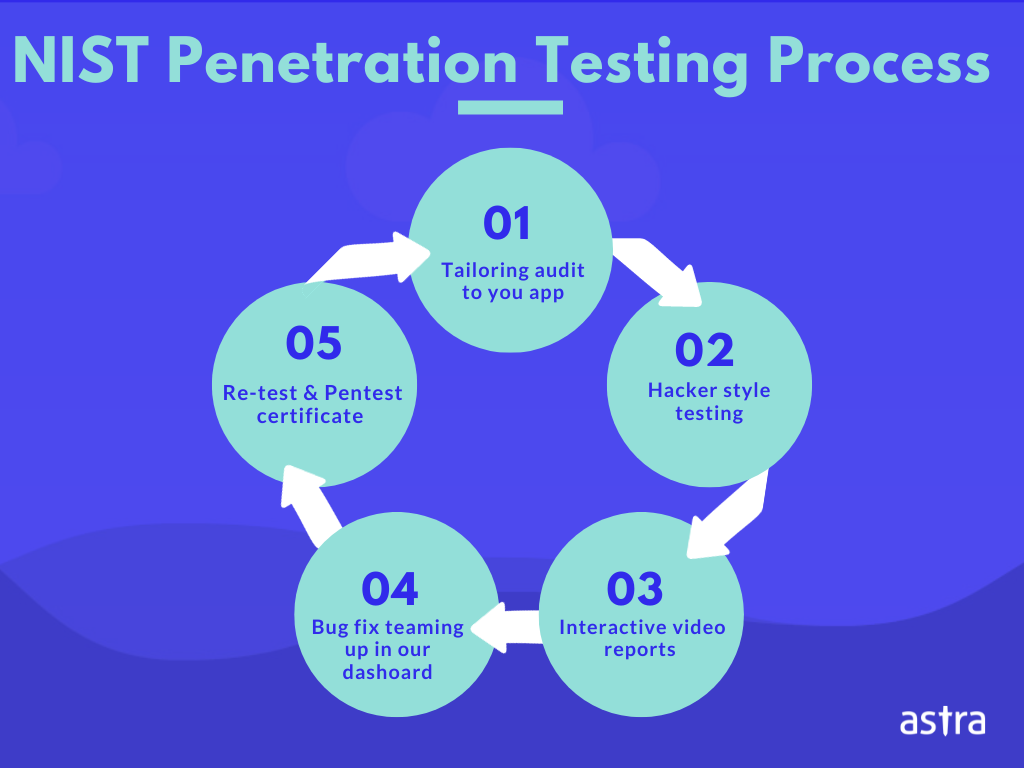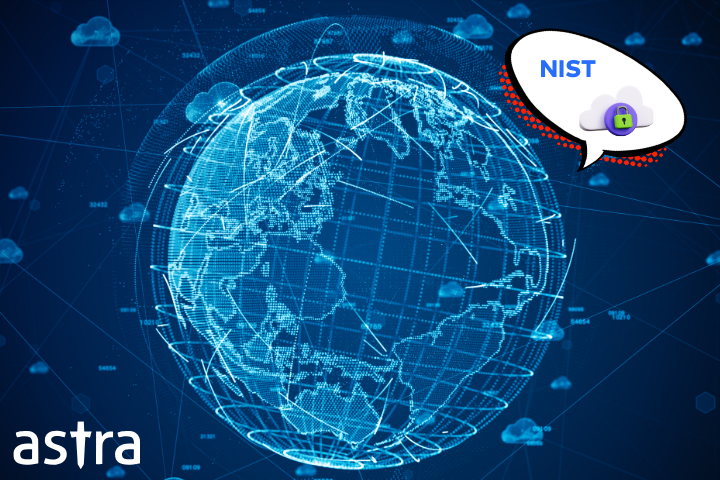Latest cloud security statistics reveal that 91% of all organizations have some portion of their IT environment hosted in cloud platforms. While cloud computing comes with many benefits, companies have trouble scaling up the security to meet the data and privacy challenges posed by it.
NIST or National Institute of Standards and Technology, a part of the U.S Department of Commerce is well known for its contributions to the advancement of technology through its physical labs, standards, and guidelines. This includes standards for NIST cloud security.
With cloud computing gaining immense popularity, NIST developed cloud security standards and frameworks to help build, standardize, and maintain secure cloud environments. This article discusses components of NIST cloud security in detail.
Action Points
- NIST Cybersecurity Framework, NIST SP 800 – 53, and NIST SP 800 – 174 address cybersecurity in cloud computing & provide security controls.
- NIST recommends carrying out regular NIST vulnerability assessments and NIST penetration tests to detect and mitigate cloud vulnerabilities.
- Other security controls important to the cloud include data encryption, anti-malware programs, firewalls, and access control measures.
- Following NIST cloud security measures can enhance your security and help standardize according to international standards.
What Is NIST Cloud Security?
NIST cloud security refers to the standards, policies, and best practices put forward by the NIST (National Institute of Standards and Technology) to efficiently manage cloud cyber security risks. NIST standards concerning cloud security include:
- NIST SP 800 – 144: Key guidelines for maintaining security & privacy in public clouds.
- NIST SP 800 – 145: Defines cloud computing, its characteristics, and its service & deployment models.
- NIST SP 800 – 146: Cloud systems along with when & how to use them are explained.
- NIST SP 800 – 53: Provides security controls for NIST CSF implementation.
- NIST SP 800 – 210: Provides access control guidance for different cloud delivery models.
- NIST Cyber Security Framework: Provides guidelines to help reduce cybersecurity risks.
- NIST Cloud Computing Resources: Dedicated catalog for cloud computing resources.
Who Does NIST Cloud Security Apply To?
Frameworks, guidelines, and security controls put forward by NIST are ideal for all companies having assets in the cloud. Most companies today have multiple cloud assets in the form of data, applications or both, therefore making implementation of the best cloud security measures integral.
Following NIST security controls such as NIST SP 800-53, NIST SP 800 -145, and others ensures that security measures apt for your cloud assets are applied for optimal protection. This usually includes risk assessments, data encryption, installation of firewalls, and more.
NIST Cloud Security Standards
NIST has introduced certain cloud security standards in the form of special publications. Its technical requirements help enhance cloud security.
While not all of them are solely related to cloud computing and its security, the below-mentioned standards address various aspects of cloud security.
NIST SP 800-144
Title – Guidelines on Security and Privacy in Public Cloud Computing
The public cloud’s security and privacy challenges are addressed in the document. Recommendations for organizations for data & application outsourcing to public cloud platforms.
NIST SP 800-144 is mainly geared toward decision-making executives, information officers, and system managers. It also mentions an exhaustive list of other SP NIST publications that directly relate to cloud computing and can be used in conjunction with NIST SP 800-144.
Key guidelines mentioned include:
- Planning of security and privacy components of cloud computing solutions carefully before implementation.
- Detailed knowledge and understanding of the public cloud computing platform offered by the provider.
- The public cloud computing solution should satisfy the organizational security and privacy criteria.
- Accountability over the privacy and security of applications and data in the public cloud platform should be maintained.
NIST SP 800 – 145
Title: The NIST Definition Of Cloud Computing
The special publication defines cloud computing, its five essential characteristics, three service models, and four deployment models. Broad comparisons of cloud services within the cloud are mentioned.
Service models include SaaS (software as a service), PaaS (Platform as a service), and IaaS (Infrastructure as a service). Deployment models for the cloud are private, community, public, and hybrid.
NIST Cloud Computing Definition
Cloud computing is a model for enabling convenient, on-demand network access to a shared pool of configurable computing resources like networks and applications that can be rapidly bought and used with minimal management effort or service provider interaction.
NIST Vital Cloud Computing Characteristics
- On-demand self-service: Users can provision cloud computing capacities based on unilateral requirements.
- Broad network access: Cloud capabilities are available over the network through daily-use devices like laptops and mobile phones.
- Resource pooling: Resources of the cloud platform serve multiple consumers dynamically according to their demand.
- Rapid elasticity: Cloud platforms provide a high level of resource scalability to meet user requirements.
- Measured service: Cloud platforms automatically control and optimize resource use with a pay-per-use policy.
NIST SP 800 – 146
Title: Cloud Computing Synopsis and Recommendations
Cloud systems are explained in the guide and suggestions for IT professionals are provided. The standard mentions how and when cloud computing is ideal for an organization.
NIST SP 800 – 146 explains different cloud deployments & technical characteristics like cloud performance, reliability, and security concerns.
NIST SP 800 – 53
Title: Security and Privacy Controls for Federal Information Systems and Organizations
NIST SP 800 – 53 mentions specific security controls to implement NIST CSF for federal organizations. Implementing the security controls is valuable for all organizations however, it mainly targets federal compliance.
The security controls help determine the requirements for securing federal agencies with various impact levels like low-impact, moderate-impact, and high-impact.
The following security controls are relevant for organizations in the cloud:
- Access Control
- Audit and Accountability
- Configuration Management
- Identification and Authentication
- Risk Assessment
- Incident Response
NIST SP 800 – 210
Title: General Access Control Guidance for Cloud Systems
This special publication was released to address appropriate access control measures for different cloud delivery models such as:
- Infrastructure-as-a-Service (IaaS)
- Platform-as-a-Service (PaaS)
- Software-as-a-Service (SaaS)
The document focuses on the technical features of access control without considering the deployment model of the cloud (hybrid, private, public). It provides access control guidance for various components of the cloud such as network, data, APIs, and privilege management.
NIST Cyber Security Framework
The NIST Cyber Security Framework was introduced with the aim of reducing cybersecurity risks for organizations of varied sectors and sizes. It does not provide specific security controls however which is done through special publications. It enables easy customization of cybersecurity practices based on individual company requirements.
NIST 800-53 among other NIST special publications provide security controls for implementing NIST CSF. It consists of three main components:
- Core: Set of high-level cybersecurity functions i.e. identify, protect, detect, respond, recover.
- Implementation Tiers: Various degrees to which NIST CSF has been implemented, partial, risk-informed, repeatable, and adaptive.
- Profiles: Refers to each organization’s unique security requirements.
NIST Cloud Computing Resources
NIST has created a dedicated webpage catalog for cloud computing resources which includes various publications, documents, and guidelines related to cloud security.
Some of the NIST special publications mentioned in this include
- Cloud Computing Security: Foundations and Challenges, Chapter 7, Managing Risk in the Cloud
- Cloud Computing Security: Foundations and Challenges, Cloud Computing Security Essentials and Architecture
NIST Cloud Security Best Practices
1. Conduct regular vulnerability assessments and penetration tests

Regular risk assessments, such as NIST vulnerability assessments and NIST penetration tests are extremely important and recommended by NIST. VAPTs aid in the timely detection, identification, exploitation, and mitigation of cloud vulnerabilities.
Astra Security offers NIST vulnerability scanning, vulnerability assessments and penetration tests that are based on NIST methodologies. The provides manual and automated testing helping in the detection of more than 8,000 vulnerabilities across the cloud, networks, mobile apps, and websites.
2. Install firewall & anti-malware software
NIST recommends strong firewalls to scan internal and external networks & filter out any malicious traffic. Anti-virus software ensures quick detection of viruses or worms in the cloud platform.
Some of the top choices for cloud firewalls include Astra Security Firewall, AWS Firewall, & Cloudflare Firewall. Astra Security also offers a malware scanner that can help keep your cloud assets safe and detect any malicious activity immediately.
3. Encrypt data at rest and in transit
It protects sensitive information from malicious threats and hackers. Use encryption methods such as encryption keys and transport layer security (TLS) to protect your data both in transit and at rest which are recommended by NIST.
4. Implement access management controls
Access management provides and maintains access control to cloud resources. NIST recommends that you employ multi-factor authentication (MFA), & role-based access control to minimize potential security breaches.
5. Have an incident response plan in place
NIST highly recommends that organizations have well-defined incident response plans that map out steps to mitigate, contain, and recover from security incidents effectively. Incident response plans decrease downtimes and recovery times for businesses.
NIST Cloud Security Benefits
Key benefits of following NIST’s cloud security guidelines and standards include:
- Robust and strong security posture in their cloud environments.
- Availability of tools and practices provided by NIST to identify and mitigate risks associated with cloud adoption.
- Aids with regulatory compliance requirements in the cloud for various compliances like SOC2, ISO 27001, PCI-DSS, and more.
- Provides best practices for increased cloud security and trust in its services.
- Emphasis on continuous monitoring for prompt detection and response to security threats.
- NIST is adaptable for various types of cloud deployment be it public, private, community, or hybrid.
- Optimizes resource usage and cost-effectiveness in securing the cloud.
Conclusion
NIST cloud security resources like standards, frameworks, and resources are invaluable in a landscape where cyber threats are a constant concern. Implementing & following NIST’s cloud security best practices, and established standards can significantly enhance organizations’ cloud security posture & reap its benefits.
This article has mentioned in detail the various NIST cloud security best practices, standards, and benefits to aid your organization’s cloud security journey.
What is NIST SP 800 – 53 in cloud security?
NIST SP 800 – 500 is a special publication document released by NIST that provides security controls for the successful implementation of cloud security measures based on the NIST cyber security framework. Relevant controls for organizations in the cloud include risk assessments, access control & configuration management.
What are NIST’s five essential cloud computing characteristics?
The five essential NIST cloud characteristics are on-demand self-service, broad network access, resource pooling, rapid elasticity, and measured service, i.e. pay per use. It enables users to provision the cloud based on their needs through devices such as laptops and mobile devices. Services can be controlled, scaled, and dynamically allocated.
What are the core NIST functions?
NIST’s core functions include identification, protection, detection, response, and recovery. NIST provides measures on listing assets, and security measures to protect them such as encryption, access control, logging & monitoring, and vulnerability scanning for detection, remediation, and recovery from vulnerabilities.
















